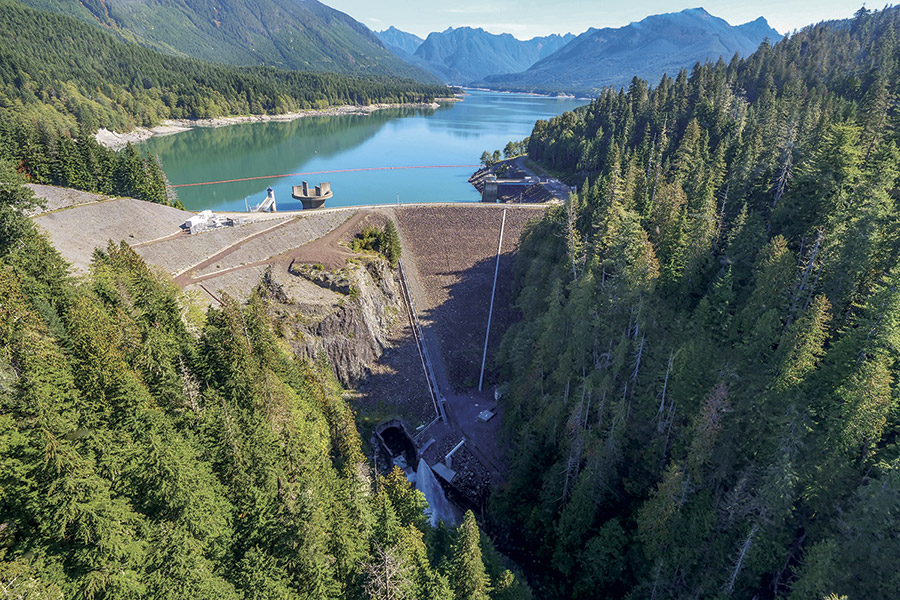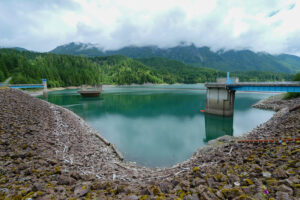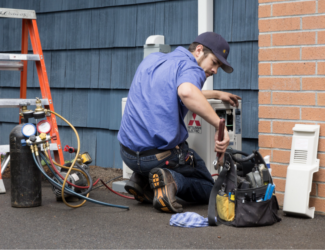
Culmback Dam safety

Eric Schneider, Designated Chief Dam Safety Engineer
Principal Engineer, Chief Dam Safety Engineer
425-783-8624
easchneider@snopud.com
Besides obligations identified in the Jackson Hydro Project license issued by the Federal Energy Regulatory Commission (FERC) for operations of the Project and environmental protections, the PUD also has independent obligations for dam safety. These obligations are identified in several safety and security plans developed and maintained by the PUD with the FERC’s oversight.
- Owner’s Dam Safety program – assures that dam safety is of the highest priority within the organization, includes: acknowledgment of dam safety responsibilities; communication requirements; designation of responsibility; allocation of resources to dam safety; and learning opportunities
- Emergency Action Plan (EAP) – identifies potential emergency conditions and inundation areas; specifies pre-planned actions for mitigating a problem and issuing early warning and notifications
- Security Plan – constitutes the “Standard Operating Procedures” relating to physical, cyber, and procedural security for the hydro project
- Dam Safety Surveillance Monitoring Plan – provides the details of how the PUD will monitor and evaluate the performance of Culmback Dam and Project structures, including frequency of readings and inspections
- Public Safety Plan – identifies signs, lights, sirens, barriers or other safety devices necessary to adequately warn and/or protect the public in its use of project lands and waters
- Earthquake Standard Operating Procedure – outlines the steps required for call-out notifications, critical assets checks and post-earthquake inspection
- FERC’s “Engineering Guidelines for the Evaluation of Hydropower Projects”
Local & emergency management agencies
Will be notified per the notification processes identified in the EAP. Local agencies and EMAs are responsible for having and implementing their own action plans.
Continuous:
- Piezometers to monitor for groundwater phreatic surface changes within the dam
- Cameras to monitor for intrusion, changes to conditions
Monthly:
- Staff visit all critical project elements to visually monitor for changes suggestive of issues
- Collection of piezometer readings to confirm SCADA values and non-continuously monitored points
Annually:
- Review, and update if needed, Emergency Action Plan (EAP)
- Train internal staff and meet with local emergency management personnel regarding EAP
- Conduct drill of EAP via phone
- Survey movement of dam, back slopes, etc.
- Inspection by FERC’s dam safety engineers from the Portland Regional Office
- Reporting to FERC ‘s Portland Regional Office
Every 5 years – next exercise May 2022:
- Conduct “Tabletop Exercise” with Local Agencies and Emergency Management Agencies (collectively, EMAs), in-depth review of EAP with no time components in conference room setting.
- Conduct “Functional Exercise” with EMA personnel, role play a scenario of dam failure with time constraints, call-outs, etc.; demonstrates workability of the EAP under a real scenario.
- Thorough inspection to comprehensively look at the dam and supporting information
As needed:
- Various facility analysis, assessment, inspection, audits
- Full-scale Exercise with local EMAs per FERC request, like the Functional Exercise plus the actual mobilization of staff and resources

Dam safety partnerships
To ensure that the public’s safety is the first priority, the PUD works closely with city officials from communities that are located in the floodplain below Culmback Dam, including Sultan, Monroe, Snohomish and Everett. PUD officials meet with city leaders, local first responders and other emergency agencies to maintain strong working relationships. As part of its Emergency Action Plan, the PUD conducts a tabletop and functional exercise with surrounding communities, local police and fire, Snohomish County Department of Emergency Management and Red Cross every five years to test the response, ensuring that it is swift, effective and concise.
Frequently asked questions
How safe is Culmback Dam?
Culmback Dam is very safe. The dam was sited in an ideal location with solid bedrock all around the dam site. It was designed to be safe and resilient for all kinds of conditions. It is designed to withstand the largest flooding the upstream basin can produce, and the largest earthquake expected for the site. The PUD has instrumentation that continuously monitors the health of the dam and would be alerted to any problems. Regular checks are made to verify the safety of the dam. In the 55-year history of the dam, there have been no issues that would be a concern for dam failure. Each year the dam is reviewed by FERC in regards to the ability to function as intended, and the dam has always received a satisfactory grade, which is the highest rating.
What is a spill event? When would the PUD spill?
The Spada Lake Reservoir level changes based on rain and resulting inflows. Sometimes during especially heavy rainfalls, the project may “spill” – safely discharging the incoming water through an overflow structure to avoid the lake level reaching the top of the dam. Large spills are rare and have only happened 6 times since 1984. These occur during the rainiest times of the year (November/December). The largest spill for the project happened in November 1990.
Are spill events dangerous?
They are not dangerous to the dam. The dam has plenty of capacity to safely discharge flows through its ”Morning Glory” spillway. The spillway has a capacity of 80,000-cubic-feet-per-second, which is more than 4-times the largest spill flow seen (17,000-cubic-feet-per-second in 1990).
With this much flood-water being passed, anyone downstream of the dam in the flood-plain could see flooding. The lake doesn’t add flow to the flooding, but the spillway does pass along the inflow from the storm causing the spill.
What is the difference between an earthen dam and a concrete dam?
Many people are more familiar with concrete dams (such as Hoover Dam or Grand Coulee Dam). However, Culmback Dam is an earthen structure. It is kept in place by gravity, meaning it is much more massive in size than an equivalent concrete arch dam. Keeping the dam water-tight is a very large clay layer (90-feet wide at the bottom) held in place by a giant pyramid of selected rock and gravel material. Because earth materials are more flexible than concrete, it is more resilient for the forces of an earthquake.
How does the PUD work with the City of Sultan prepare for an emergency evacuation?
The PUD regularly meets with the Sultan Fire Department and other downstream emergency management organizations to discuss dam safety and the PUD’s Emergency Action Plan. The PUD contributed funding to the City of Sultan, which was used to purchase the city’s sirens. Also, the PUD hosts a training exercise to simulate a response to a failure at Culmback Dam every five years.
What benefits does Culmback Dam provide for flood management?
The level of Spada Lake Reservoir is purposely kept lower during the fall and winter when large storms are expected. This means that Culmback Dam and Spada Lake Reservoir captures the flows from most severe storms without having to spill. By doing so, the floodwaters downstream on the Sultan River are significantly reduced from what they would otherwise be. However, when the capacity of Spada Lake Reservoir is filled, the additional flows caused by the storm are passed through our spillway.
How does the PUD monitor the dam?
The PUD monitors the dam in a number of different ways. Instruments such as groundwater monitors (piezometers) and seismic monitors are embedded within the dam. Other instruments monitor the lake level and downstream river flow. If any one of these instruments detects a problem, an alarm is sent to PUD personnel who work all-hours and will follow-up.
In addition, regular checks are made to measure for settlement or ground motion around the dam. Oversight is provided by the Federal Energy Regulatory Commission that provides a standard of care that the PUD must follow.
How would an earthquake affect the dam?
The large earthquakes predicted for western Washington (such as the Cascadia event) or a random earthquake near the dam have been reviewed against the dam and its key structures and were found that they would NOT fail the dam. Nevertheless, the PUD would plan to investigate immediately following any earthquake to rule out any damage.
What does the PUD do to prepare for an emergency with the dam?
The PUD rigorously monitors the dam to detect any signals of a problem. In addition, the PUD maintains an Emergency Action Plan that identifies the monitoring used to detect any problems with the dam, describes the notifications that would be made, and identifies resources that could be used in an emergency. The PUD annually meets with the downstream emergency management agencies to discuss response tactics. Also, the PUD completes an annual call-out of the notification tree and every five years completes a functional exercise wherein downstream emergency responders participate in an actual simulation of a dam failure event.
What requirements must the PUD meet under its operating license?
The 45-year license under which the PUD operates the project contains requirements for all manner of project operations. This includes releasing appropriate flows and water quality for fish, managing the lands surrounding the project, keeping Spada Lake Reservoir at certain levels throughout the year, etc. For dam safety, the regulation by the Federal Energy Regulatory Commission includes an annual inspection, annual reporting of monitoring of the dam, and review of the project by an “Independent Consultant” who reviews all of the prior design and makes recommendations to FERC for further investigations if necessary.






